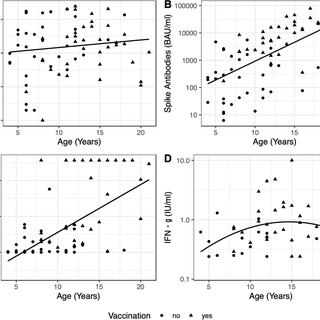March 2024
·
28 Reads
Infection
Purpose In contrast to adults, immune protection against SARS-CoV-2 in children and adolescents with natural or hybrid immunity is still poorly understood. The aim of this study was to analyze different immune compartments in different age groups and whether humoral immune reactions correlate with a cellular immune response. Methods 72 children and adolescents with a preceding SARS-CoV-2 infection were recruited. 37 were vaccinated with an RNA vaccine (BNT162b2). Humoral immunity was analyzed 3–26 months (median 10 months) after infection by measuring Spike protein (S), nucleocapsid (NCP), and neutralizing antibodies (nAB). Cellular immunity was analyzed using a SARS-CoV-2-specific interferon-γ release assay (IGRA). Results All children and adolescents had S antibodies; titers were higher in those with hybrid immunity (14,900 BAU/ml vs. 2118 BAU/ml). NCP antibodies were detectable in > 90%. Neutralizing antibodies (nAB) were more frequently detected (90%) with higher titers (1914 RLU) in adolescents with hybrid immunity than in children with natural immunity (62.5%, 476 RLU). Children with natural immunity were less likely to have reactive IGRAs (43.8%) than adolescents with hybrid immunity (85%). The amount of interferon-γ released by T cells was comparable in natural and hybrid immunity. Conclusion Spike antibodies are the most reliable markers to monitor an immune reaction against SARS-CoV-2. High antibody titers of spike antibodies and nAB correlated with cellular immunity, a phenomenon found only in adolescents with hybrid immunity. Hybrid immunity is associated with markedly higher antibody titers and a higher probability of a cellular immune response than a natural immunity.

























